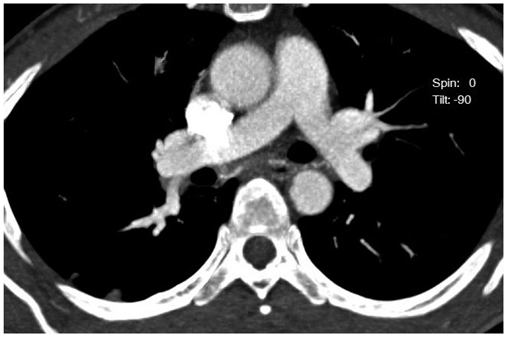Korean Circ J.
2012 May;42(5):345-348. 10.4070/kcj.2012.42.5.345.
Recurrent Deep Vein Thrombosis due to Thrombophilia
- Affiliations
-
- 1Department of Cardiology, Sir Salimullah Medical College & Mitford Hospital, Dhaka, Bangladesh.
- 2Department of Cardiology, National Institute of Cardiovascular Diseases, Dhaka, Bangladesh. drmonwarbd@yahoo.com
- 3Department of Cardiology, Zia Heart Foundation Hospital and Research Institute, Dinajpur, Bangladesh.
- KMID: 2028764
- DOI: http://doi.org/10.4070/kcj.2012.42.5.345
Abstract
- Deep vein thrombosis (DVT) is a common condition that is often under-diagnosed. Acquired or hereditary defects of coagulation or a combination of these defects may facilitate the development of DVT. Recurrent DVT, a positive family history or unusual presentation may warrant investigation for hereditary thrombophilia. Investigations are best when conducted at least one month after completion of a course of anticoagulant therapy. Most patients are managed with heparin in the acute stage overlapped by warfarin. The case presented here describes a 40-year old man undergoing three episodes of DVT. Investigations revealed protein C and protein S deficiency. Protein C, protein S and antithrombin deficiency either singly or in combination, are relatively common causes of hereditary thrombophilia. The case presented here serves as a reminder of the need to look into the underlying cause of venous thromboembolism.
Keyword
MeSH Terms
Figure
Reference
-
1. White RH. The epidemiology of venous thromboembolism. Circulation. 2003. 107:23 Suppl 1. I4–I8.2. Silverstein MD, Heit JA, Mohr DN, Petterson TM, O'Fallon WM, Melton LJ 3rd. Trends in the incidence of deep vein thrombosis and pulmonary embolism: a 25-year population-based study. Arch Intern Med. 1998. 158:585–593.3. Carter CJ. Hull RD, Pineo GF, editors. Epidemiology of venous thromboembolism. Disorders of Thrombosis. 1996. Philadelphia: WB Saunders;159–174.4. Maheshwari A, Mehrotra A, Henry R, et al. Abela GS, editor. Deep veins thrombosis. Risk and management. Peripheral Vascular Disease: Basic Diagnostic and Therapeutic Approaches. 2004. Philadelphia: WB Saunders;452–460.5. Nicolaides AN, Breddin HK, Carpentier P, et al. Thrombophilia and venous thromboembolism. International Consensus Statement. Guidelines according to scientific evidence. Int Angiol. 2005. 24:1–26.6. Makris M, Preston FE, Beauchamp NJ, et al. Co-inheritance of the 20210A allele of the prothrombin gene increases the risk of thrombosis in subjects with familial thrombophilia. Thromb Haemost. 1997. 78:1426–1429.7. Price DT, Ridker PM. Factor V Leiden mutation and the risks for thromboembolic disease: a clinical perspective. Ann Intern Med. 1997. 127:895–903.8. Seligsohn U, Zivelin A. Thrombophilia as a multigenic disorder. Thromb Haemost. 1997. 78:297–301.9. Murin S, Marelich GP, Arroliga AC, Matthay RA. Hereditary thrombophilia and venous thromboembolism. Am J Respir Crit Care Med. 1998. 158:1369–1373.10. Heijboer H, Brandjes DP, Buller HR, Sturk A, ten Cate JW. Deficiencies of coagulation-inhibiting and fibrinolytic proteins in outpatients with deep-vein thrombosis. N Engl J Med. 1990. 323:1512–1516.11. Pabinger I, Brucker S, Kyrle PA, et al. Hereditary deficiency of antithrombin III, protein C and protein S: prevalence in patients with a history of venous thrombosis and criteria for rational patient screening. Blood Coagul Fibrinolysis. 1992. 3:547–553.12. Thomas RH. Hypercoagulability syndromes. Arch Intern Med. 2001. 161:2433–2439.13. Miletich J, Sherman L, Broze G Jr. Absence of thrombosis in subjects with heterozygous protein C deficiency. N Engl J Med. 1987. 317:991–996.14. Walker ID. Hoffbrand AV, Catovsky D, Tuddenham EG, editors. Inherited thrombophilia. Postgraduate Haematology. 2005. Oxford: Blackwell;885–899.15. Hao WR, Kao PF, Leong YL, et al. Recurrent deep vein thrombosis caused by inherited coagulopathy in a Japanese male. Acta Cardiol Sin. 2008. 24:157–160.16. Rees CD, Cox M, Clegg JB. World distribution of factor V Leiden. Lancet. 1995. 346:1133–1134.17. D'Angelo A, Selhub J. Homocysteine and thrombotic disease. Blood. 1997. 90:1–11.18. Bauer KA. The thrombophilias: well-defined risk factors with uncertain therapeutic implications. Ann Intern Med. 2001. 135:367–373.19. Schulman S. Hoffbrand AV, Catovsky D, Tuddenham EG, editors. Management of venous thromboembolism. Postgraduate Haematology. 2005. Oxford: Blackwell;912–924.
- Full Text Links
- Actions
-
Cited
- CITED
-
- Close
- Share
- Similar articles
-
- A Case of Pediatric Unprovoked Deep Vein Thrombosis due to Combined Hereditary Thrombophilia of Antithrombin III and Protein S Deficiency
- The Incidence of Deep Vein Thrombosis in the Lower Extremity
- Portal Vein Thrombosis during Pregnancy
- A Case of Upper Extremity Deep Vein Thrombosis and Pulmonary Thromboembolism in a Severely Obese Man
- Renal Cell Carcinoma with Deep Vein Thrombosis





